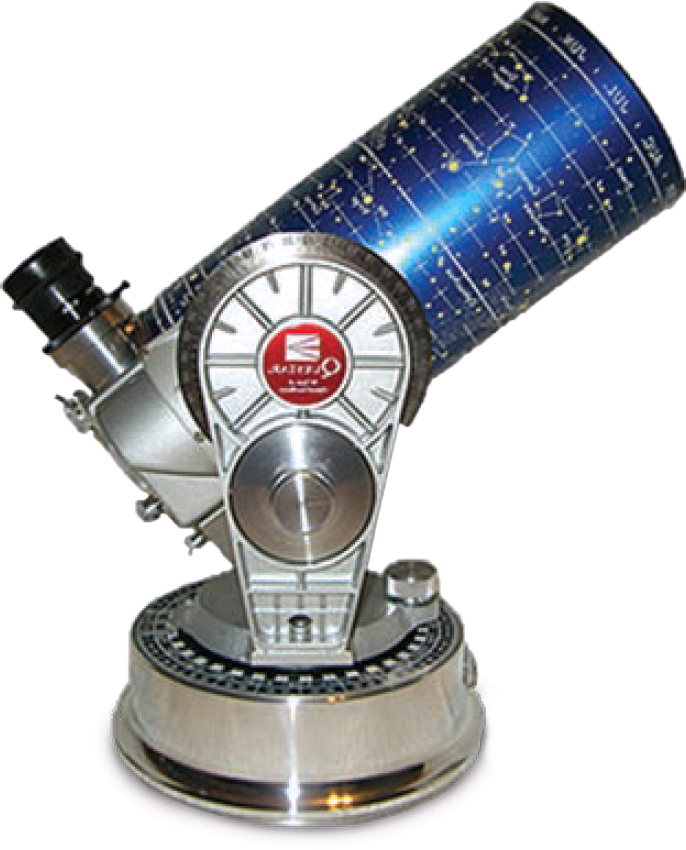
It didn’t take birders who had been in the armed forces long to adapt the optics of warfare to finding and bringing birds within closer range, but Questar was the first company to develop a telescope specifically for the hobby.
58 : Questar telescope
1954

It didn’t take birders who had been in the armed forces long to adapt the optics of warfare to finding and bringing birds within closer range, but Questar was the first company to develop a telescope specifically for the hobby.
Most wild birds are innately wary, so the problem for anyone who wants to watch or study them in detail is how to do so without disturbance. Skills developed through hunting, such as stalking or hiding, can sometimes be usefully deployed, but the ideal way to get close to a suspicious or uncooperative bird is to do it with magnifying optics. While binoculars have a long and important history in this respect (see pages 88–89), the practical limitations of magnification for a hand-held instrument mean that in birding situations, a telescope is frequently the best option.
‘Scopes’ have a considerable history, dating back to the first revelatory and revolutionary uses of lenses to bring objects closer, and birds were almost the first objects to be viewed through an arrangement of consecutive lenses in a cylinder. Primitive quartz lenses are known from prehistory, and were used for reading and starting fires by the 12th century.
Corrective concave lenses were being combined in a frame as spectacles by the late 1400s, but the idea for placing both a concave and convex lens together to see over a distance is generally attributed to a letter written by Giambattista della Porta in 1586.
The first telescopes had been invented in The Netherlands by 1608, collecting visible light through simple glass lenses and mirrors. The invention is attributed variously to Hans Lippershey, Sacharius Jansen (both spectacle makers) or Jacob Metius, and Lippershey’s at least was capable of a 3x magnification or so. Possibly apocryphally, it is told that Lippershey’s children used two of his lenses in tandem to look at birds nesting under a church spire, thus effectively using them for birding before astronomy, and inspiring him to mount them in a tube. News of this discovery had reached Galileo by 1609, and he was already developing the device for astronomical use only one year after that.
It wasn’t until the 20th century that the instrument diverged into the many forms known today. Originally intended for the amateur astronomer, the Questar 3.5” was the first commercially available compact telescope, though far from affordable, and was soon used for watching wildlife after its introduction in 1954. The Questar Birder model appeared just a few years later, with an angled eyepiece and magnifications of 40x and 160x.
Initially its use was difficult, as, along with the wind-wobble expected at high magnifications, the image was counter-intuitively reversed, meaning that a bird moving from left to right would appear to be moving in the opposite direction through the scope. Its appearance has remained pretty much the same since it first hit the market.
Questar models were beyond most birders’ budgets, and the most popular affordable scopes were probably Broadhurst Clarkson brass draw-tube models, initially designed for military use in the 19th century and representing good value for clarity and brightness. The Mark I to Mark VI were introduced until just after the Second World War, and came in their own fetching ‘boy scout’ brown leather protective case, had a 5cm aperture, 7.5cm sunscreens at the end, and could be extended up to 80cm in some models, with a top magnification of 40x.
This sounds good, but telescopes with the nature watcher/hunter in mind had been manufactured since the late 19th century with magnifications up to at least 40x, though quality was minimal. Brass telescopes are still on sale today, mostly for the astronomy and ornamental markets.
The beginning of the 1970s saw basic draw-tube, naval-style scopes superseded by the fixed-length Supra made by Nickel AG, a company best known for its hunting scopes and rifle sights. As such models were adopted by birders, the money to be made from this emerging market was becoming apparent, and there was soon a preponderance of high-end choice which has continued to increase to this day. Tripods and car mounts were already in use (see pages 182–183), the former from photography and the latter from hunting.
Angled eyepieces were an early innovation during this expansion, to enable taller birders get a comfortable view, minimise wind vibration at a lower tripod setting or for detailed notes and sketches to be made without taking an eye off the bird. Interchangeable eyepieces also took off, allowing zoom and wide-angle usage as well as the more usual fixed magnification. Far from being limited to a co-opted astronomical scope, birders could make purchases according to specialised field requirements, taste and budget. The growing popularity of birdwatching saw most optics companies enter the market, and as identification skills have become more forensic, higher-quality telescopes are in great demand.